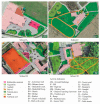School Children's Physical Activity and Preferred Activities during Outdoor Recess in Estonia: Using Accelerometers, Recess Observation, and Schoolyard Mapping
- PMID: 37189951
- PMCID: PMC10136911
- DOI: 10.3390/children10040702
School Children's Physical Activity and Preferred Activities during Outdoor Recess in Estonia: Using Accelerometers, Recess Observation, and Schoolyard Mapping
Abstract
Studies about recess have found that children have higher physical activity (PA) during outdoor recess compared to indoor recess, and well-constructed schoolyards play an important role in stimulating PA in children. This study aimed at investigating the affordances of schoolyards and outdoor recess PA in two urban and two rural primary schools in Estonia. Schoolyards were described with the geographical mapping method, children's activities during outdoor recess were registered by using observations, and PA levels were measured with accelerometers. Students from grades two to six (8-13-year-olds) were included in the study. All observed schoolyards had different spaces including various ball game areas, climbing facilities, and slacklines. The natural environment dominated in the rural schools, and artificial surfaces dominated in the urban schools. Boys in the study tended to enjoy more sport-related activities, whereas girls preferred more social and less active activities. Students participating in outdoor recess spent about twice as much time (20.4%) on moderate-to-vigorous PA (MVPA) compared to indoor recess (9.5%), although boys were more active than girls (22.9% vs. 17.3%). All schoolyards afforded more MVPA during outdoor recess compared to indoor recess, whereas schoolyards with more space per child and natural environment elements generated more varied PA and higher MVPA. These findings confirm the importance of schoolyard design and quality for the variety and intensity of students' PA during outdoor recess.
Keywords: MVPA; accelerometer; affordances; outdoor recess; physical activity; school children; schoolyard.
Conflict of interest statement
The authors declare no conflict of interest.
Figures
References
-
- World Health Organization . WHO Guidelines on Physical Activity and Sedentary Behaviour: Web Annex: Evidence Profiles. World Health Organization; Geneva, Switzerland: 2020.
-
- Poitras J.V., Gray C.E., Borghese M.M., Carson V., Chaput J.P., Janssen I., Katzmarzyk P.T., Pate R.R., Gorber S.C., Kho M.E., et al. Systematic review of the relationship between objectively measured physical activity and health indicators in school-aged children and youth. Appl. Physiol. Nutr. Metab. 2016;41:S197–S239. doi: 10.1139/apnm-2015-0663. - DOI - PubMed
-
- Muntaner-Mas M., Martinez-Gomez D., Castro-Piñero J., Fernandez-Santos J.R., Salmon J., Veiga O.L., Esteban-Cornejo I. Objectively measured physical activity and academic performance in school-aged youth: The UP&DOWN longitudinal study. Scand. J. Med. Sci. Sports. 2021;31:2230–2240. doi: 10.1111/sms.14036. - DOI - PubMed
Grants and funding
LinkOut - more resources
Full Text Sources


